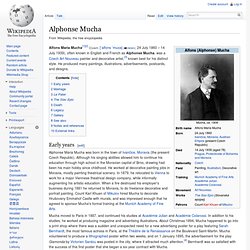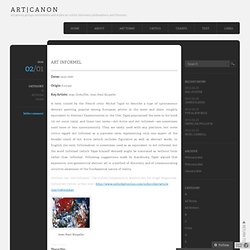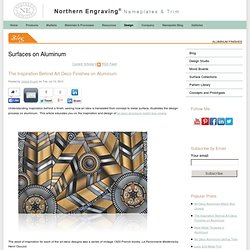

Alphonse Mucha. Alfons Maria Mucha[1][2] (Czech: [ˈalfons ˈmuxa] ( ); 24 July 1860 – 14 July 1939), often known in English and French as Alphonse Mucha, was a Czech Art Nouveau painter and decorative artist,[3] known best for his distinct style.

He produced many paintings, illustrations, advertisements, postcards, and designs. Early years[edit] Alphonse Maria Mucha was born in the town of Ivančice, Moravia (the present Czech Republic). Although his singing abilities allowed him to continue his education through high school in the Moravian capital of Brno, drawing had been his main hobby since childhood. Mucha moved to Paris in 1887, and continued his studies at Académie Julian and Académie Colarossi. Poster design by Mucha for Cycles Perfecta (1902) Marriage[edit] Mucha married Maruška (Marie/Maria) Chytilová on 10 June 1906, in Prague. Le Pater[edit] The Slav Epic[edit] A study of a man sitting 1891. Google Image Result for. Google Image Result for. Google Image Result for. The History of Art Nouveau. During the turn of the 20th century the style of art which was followed was known as Art Nouveau.

This form of art is also known as Jugendstil. This type of art prevailed in the 19th century and it is featured by organic subjects particularly the floral ones. The artist was inspired by the flora and fauna and the subject of their paintings were graceful curved forms and plants and animals. Louis Comfort Tiffany was responsible to bring the Art Nouveau movement in the United States. This form of painting was influenced more on ornamental than spatial designing. Tiffany found a way to combine color with nature and decoration. Art Nouveau was an era where by arts and crafts were made of simple clean patterns and where individual craftsmanship was employed. Google Image Result for. ART INFORMEL « A R T. Dates: 1940-1960 Origin: Europe Key Artists: Jean Dubuffet, Jean-Paul Riopelle A term coined by the French critic Michel Tapié to describe a type of spontaneous abstract painting popular among European artists in the 1940s and 1950s, roughly equivalent to Abstract Expressionism in the USA.

Tapié popularized the term in his book Un art autre (1952), and these two terms—Art Autre and Art Informel—are sometimes used more or less synonymously. They are rarely used with any precision, but some critics regard Art Informel as a narrower term, representing only one aspect of the broader trend of Art Autre (which includes figurative as well as abstract work). Jean-Paul Riopelle. Google Image Result for.
Art Informel Movement, Art Informel Style, Art Informel Pictures. Art Informel The Art Informel style was developed between 1950 to 1960. The term was first used in 1952 by the French writer Michel Tapie who is the author of the book ‘Un Art Autre’ or ‘Art of Another Kind’. Tapié saw this art as 'other' because it appeared to him as a complete break with tradition. An important source of this kind of painting was the Surrealist doctrine of automatism. An exhibition titled Un Art Autre was organised in Paris the same year as Tapié's book and included Appel, Burri, De Kooning, Dubuffet, Fautrier, Mathieu, Riopelle, Wols.
After WWII painters contemplated the legacy of geometric abstraction characterized in the early 20th century developments (through Cubism, Futurism, Suprematism, Constructivism and De Stijl) as a load and the cold intellectualism, out of touch with the post WWII reality of poverty and despair. From the reaction was born a new painting style which was fully abstract but didn't rely on intellectualist methodology. Most Notable Artists: Google Image Result for. The Inspiration Behind Art Deco Finishes on Aluminum. Customer Spotlight -"With an unlimited choice of patterns produced by a design department whose creativity is second to none.

It is a pleasure to be a Designer and work with Northern Engraving. " -Gunnar Johansson, Chief Designer, Volvo Cars Aluminum Finish Trend Presentation Video Want to push the boundaries in decorative trim? The trend presentation covers finishes developed around themes presented as mood boards. Google Image Result for. Google Image Result for. Art Deco. Historian Bevis Hillier defined Art Deco as "an assertively modern style [that] ran to symmetry rather than asymmetry, and to the rectilinear rather than the curvilinear; it responded to the demands of the machine and of new material [and] the requirements of mass production".[2] During its heyday, Art Deco represented luxury, glamour, exuberance and faith in social and technological progress.

§Etymology[edit] The first use of the term Art Deco has been attributed to architect Le Corbusier, who penned a series of articles in his journal L'Esprit nouveau under the headline "1925 Expo: Arts Déco". He was referring to the 1925 Exposition Internationale des Arts Décoratifs et Industriels Modernes (International Exposition of Modern Decorative and Industrial Arts).[3] §Origins[edit] Joseph Csaky, Deux figures, 1920, relief, limestone, polychrome, 80 cm. Paul Iribe created for the couturier Paul Poiret esthetic designs that shocked the Parisian milieu with its novelty. Google Image Result for. Flower Quotes Page 2.